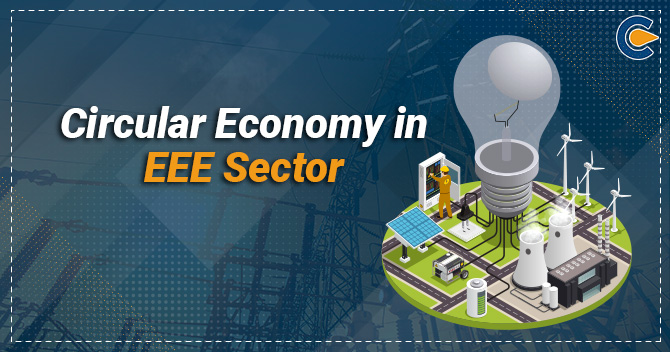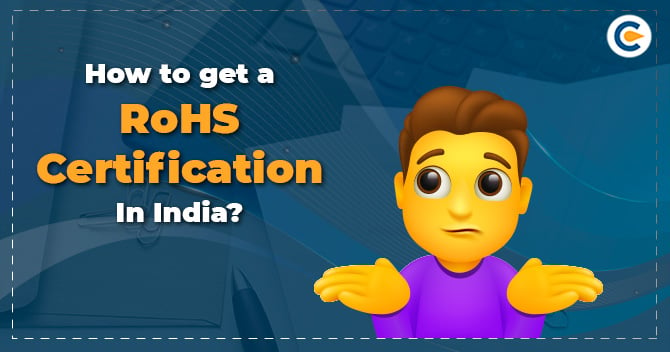EEE manufacturing is totally dependent on high material consumption along with rare elements of the earth. A circular economy in EEE sector is a good approach to fulfilling the resource needs as the rate of extraction of the resources of EEE is significantly high.
Circular Economy in EEE sector is receiving attention from policymakers as a concept to support the aim of reducing overconsumption of natural resources while deriving economic benefits. A Circular Economy in EEE sector is required, and the decision-makers of India need support to deal with the complexities coming with this change. Unlike the linear economy, where value creation relies on flows of virgin materials, the circular economy is based on logic, where its key principle is that value creation is based on utilizing the economic value which is retained in the products.
Introduction to Circular Economy in EEE sector
A Circular Economy in EEE sector is restorative and regenerative by design as it replaces the end to life concept with restoration, regeneration, etc.; it shifts towards the use of renewable energy and eliminates the use of toxic chemicals. It repairs, reuses and returns the materials to the environment with the aim of eliminating waste through innovative designs of products. Circular Economy in EEE sector aims at minimizing wastage at each stage, extracting the maximum value by reusing, repairing, recovering, remanufacturing and regenerating products as well as the materials.
Circular Economy in EEE sector approaches the management of electronic waste as resourcing efficiency, reducing pollution and waste, long life of the product, recovery of rare materials, minimizing the health hazards and giving birth to the evolution of the recycling industry. To achieve all this, the approach of circular Economy in EEE sector will necessitate the changes relating to the eco-design and sustainable manufacturing of EEE, sustainable consumption through the reduction of the volume of electronic waste.
The approach to circular Economy in EEE sector is significant for the growth of the domestic electronics manufacturing sector. The transition from the linear to circular economy is key to growth for EEE sector.
The action plan on circular economy in the EEE sector supports creating a sustainable product policy initiative for India; the circular economy approach focuses on material acquisition, design and production, consumption, recovery and utilization of the material.
Circular Economic opportunity
A circular economy in the EEE sector has the potential to create a significant economic impact. The circular Economy in EEE sector has the potential to create job opportunities. It can enable greater production, leading to skilled jobs in the sector. It also promotes innovation and research infrastructure in the sector. This enhances the resource efficiency of the collected wastes through the informal waste picking method and better economic benefit. It encourages innovation and the creation of a business model and offers an opportunity for integration of the informal sector by making a greater investment in waste recycling technologies and developing the domestic recycling industry with blended financing options.
A circular economy in EEE sector can enhance job and livelihood opportunities and thus can reduce the poverty of the nation.
It also provides environmental benefits such as reduction in the volume of waste and enhancement of resource recovery from electronic waste, which will somehow reduce extraction pressure. Even the reduced pressure has the potential to provide more opportunities. All the environmentally friendly recycling technologies can prevent pollution from generating from the old recycling methods. Sustainable or circular products can lead to reducing the generation of waste as well as pollution, and it also saves cost.
Tools and Practices for enabling circular Economy in EEE sector
In this era of sustainable development, the world is focusing on the need to adopt a circular economy in EEE sector for a safe and healthy environment. The action plan of a circular economy includes legislative as well as non-legislative measures or policies.
The Government of India has started focusing on the need for the opportunities offered by a circular economy. In India, NITI Aayog has published some strategy papers on the policy direction that can be implemented in the circular economy. The Ministry of Electronics and Information Technology formulated a strategy for resource efficiency in the EEE sector. The Ministry of Environmental and Forest & Climate Change[1] has also notified the E-waste (Management) Rules, 2016 on the first day of October 2016.
There are different kinds of policies/ tools that are used to derive the adaptation of a circular economy in EEE sector:
Information-Based Strategies
The voluntary environment agreements can be used in a case where industry front runners are willing to take any lead and drive changes that can lead to significant life cycle benefits (environmental). There is a need for information flow between different actors to improve the environmental performance of products. Such information flow is needed between the suppliers and the manufacturers, the manufacturers and the consumers and the manufacturers and the recyclers. The strengthening of such instruments, which are information-based, is supported to create consumer demand for products and their behaviour to be more sustainable.
Market-Based Instruments
An approach needs to be discussed to give incentives to manufacturers for developing green products with the aim of moving the market in a sustainable direction. Those products are identified which have the best environmental performance on the market, and their manufacturers are recognized. The standards need to be established based on the products in the market with the best environmental performance.
Those manufacturers are assessed who make efforts in the circular economy promotion. The front runners are treated as trusted partners by public authorities and may be invited to participate in the process offsetting the future policies to utilize their expertise. The approach must focus on the industry sector or product group, and initiate such an approach; the following actions can be taken:
- The development of transparent criteria for the identification of products having the best environmental performance in the focused industry.
- Identification of standards-based products having the best environmental performance within a time period.
- Identification of schemes or incentives for the front runners.
- Identification of other manufacturers whose products reach the standards-based and have the best environmental performance within a time period.
The procurement of sustainable products will motivate the producers to change their product design for their longer life, and thus transition to the green products will begin for consumers also. Such procurement will be called Green Public Procurement, and it will be used as a policy tool to promote different social purposes for supporting small scale businesses, protecting human rights, improving energy efficiency, reducing environmental impact, etc. This procurement gives benefits to the environment by stimulating the demand for greener products. The priorities of such procurement are:
- Strongly coherent with the spirit of regulation concerning public procurement.
- The purchasing organization should have the right to select the environmental aspect according to their need.
Regulatory Instruments
The recycling of end-of-life solar panels can ensure the recovery of valuable resources. Under the Compulsory Registration Scheme for EEE, by requiring producers to declare the weight of all products at the time of applying for registration, the problem of the present time can be solved.
Circular Economy in EEE sector can impact the quantum of electronic waste available due to refurbishing and repurposing the extended life. This will have an interdependence between the stakeholders and will also new participants. The policy makers should consider implementing the circular economy in informal sectors too.
The target under this heading should be the followings:
- Engage the informal sector in electronic waste rules
- Effective management and monitoring of hazardous electronic wastes.
There should be de-pollution practices and monitoring to track the hazardous post dismantling of the products to calculate the total recycled electronic wastes.
A centralized system to monitor the EPR implementation should b developed. The process of EPR should be digitalized. There should be a digital system to enable data sharing between the enforcement bodies. This will help in sharing information about producer targets, collection channels, collection, awareness and recycling of all the collected wastes.
The National Circular Economy Council is established to promote a circular economy in India. It is essential to create a receptive and suitable policy for electronic waste management. It creates an opportunity to exchange information and feedback, also to obtain financial and personnel support and negotiate to avoid potential conflict.
Recommendation to entail circular Economy in EEE sector
The Ministry of Electronics and Information Technology policy paper has formulated a policy paper for a circular Economy in EEE sector. It has focused on the lifecycle of electronics and recommended an action plan for implementing a Circular economy in EEE sector:
- Institutional arrangements to track the availability of critical materials
- Incentives to set up the infrastructures for producers.
- Design the future Production Linked Incentive Scheme for Government
- The skill development programme
- Circular economy labelling
- Eco-labelling on products that how much % of recycled materials are used.
- Promote Green Public Procurement
- Green Skill Development Programme for the informal sector
- Informal sector formation into a collection
- Strengthening of urban local bodies in waste collection
- Strengthening the recycling system with a focus on the de-pollution practices
- Introduction of recovery targets
- National Circular Economy Council
- Enhancing the competence of the value chain
- Periodically revising the E-waste Management Rules, 2016.
Conclusion
The circular Economy in EEE sector is important for electronics and especially for the consumers of the electronics market. The circular economy is playing a vital role in transforming the effect of EEE sector on the health of humans and the environment. It will reduce greenhouse emissions, save rare resources, and protect humans from health hazards caused due to electronic waste. It will make the EEE sector more sustainable. It has made positive changes in the EEE sector, such as using more recyclable materials in electronics products and designing electrical products for longer use. Now the electronic product which is not suitable for further use is collected and recycled for reuse. With the health hazards, it also prevents pollution.
Read our Article:Consent to Establish Vs Consent To Operate: Key Differences











